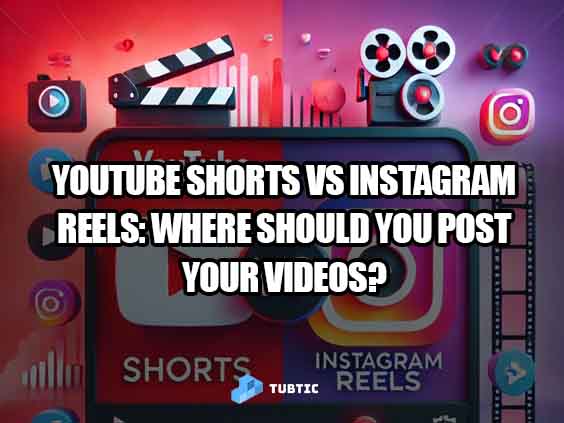Over 50% of people on the planet utilize social media, specifically Facebook, Instagram, TikTok, and YouTube. In order to compete for the hearts of social media users from a wide range of ages, genders, occupations, and other backgrounds, these three large corporations have competitively shared the market and consistently develop.
Short, vertical videos are currently preferred by social media users. Even Facebook has changed its features, such as reels like Instagram, from its beginnings as a social media social network concept. In 2020, YouTube even launched the YouTube Shorts feature, which is a tool for short videos. Users are drawn to this brief film because it is arguably relatively brief but packed with information, and it allows users to swipe right away to another brief movie.
Suppose you wish to share a brief video and anticipate receiving positive feedback and a sizable following. Which would you upload videos on Instagram Reels or YouTube Shorts? To make the most of your material, let's talk.
Instagram Reels are integrated with Instagram. Once users are in the app, they may click the Explore tab to view a selection of photographs and Reels and select which one to watch. Alternatively, they can utilize the search button to enter a certain hashtag or account name.
Although independent, YouTube Shorts is accessible through the main YouTube feed. By recommending your short videos to viewers of longer YouTube videos, you may be able to reach a larger audience.

1. Content Qualities
The first thing that needs to be decided is the type of material you will produce and its focus. This is because, despite the fact that the purpose is entertainment, the two platforms have different focal inclinations.
Since being hosted by YouTube, YouTube Shorts is more populated with videos on a variety of globally popular subjects. Additionally, instructional films, tutorials, and informational videos predominate on YouTube Shorts.
The purpose of YouTube Shorts is to give artists greater flexibility when producing educational and informative content in both short and long formats, even though it does not currently offer a variety of trend filters and visual effects. Additionally, YouTube Shorts supports automatic captioning, numerous clips in a single video, and short videos with closed captions.
Instagram is widely used as visual content to introduce products, and Instagram Reels is primarily made up of videos regarding current challenges or challenges that are trending. The filters on Instagram Reels facilitate this, including the option of a music background, a large assortment of augmented reality filters, and text filters to add trend-driven dynamic elements to your material. For content producers who wish to provide visually beautiful, current, and fashionable content, this is perfect.
2. The Audience
Considering the above-mentioned content focus, it can be inferred that their audiences varied as well, with practically every demographic including children using YouTube Shorts. According to statistics, YouTube has 2.7 billion users worldwide, and YouTube Shorts has received 70 billion views since its debut and continues to do so. In contrast, Instagram is more popular among young people, with 2 billion active users.
3. Engagement
You might think about the engagement provided by both after making the video and identifying the next audience. Long-term, consistent engagement is possible with YouTube Shorts. The YouTube recommendation algorithm will function and may even offer long-term engagement from short videos you have posted for a long time if you regularly submit videos in the niche you are interested in. For creators who wish to sustain interaction with consistent users, YouTube Shorts are a good option.
Instagram Reels may increase engagement quickly. You can find your Reels in the Reels section's explore menu. This makes it possible for people to find your content fast and for interaction to increase right at the start of your article. Instagram Reels are ideal for creatives who wish to take advantage of trends or rapidly increase their following.
4. Monetization
Due to the possibility of earning money, monetization is currently one of the primary factors driving people to become content creators. Instagram Reels and YouTube Shorts pay producers in slightly different ways.
YouTube Shorts pays out in shorts money and ad shares. Since 2023, YouTube has only allowed video creators who produce YouTube Shorts to include ad sharing. Previously, YouTube Shorts awarded $100 million in Short Funds to producers as a bonus for shorts with high interaction, independent of subscriber count, so that content creators could receive ad shares from both short and long-duration videos.
Instagram Reels offers few ways to make money. Instagram tested a concept called Bonus Reels concept that was comparable to the YouTube Fund. There was little dissemination of this program. With Instagram Shopping, affiliate marketing, and sponsored content, content creators can make money from their accounts. However, you will need to have a well-established account and a well-established image, which may take three or six months to develop.
Therefore, Instagram offers opportunities for monetization through affiliate partnerships in the fashion and beauty industries, despite the fact that it is not as comprehensive as YouTube in terms of generating revenue from short-duration videos.
Conclusion
On the other hand, Instagram Reels can help you develop more quickly if you are targeting a largely young, visually-oriented audience centered on trends and lifestyles like fashion and beauty.
Therefore, develop a thoughtful content strategy, establish a strong personal brand, stick to it, and be creative in your area. To acquire the proper blend on both platforms, test and evaluate on both.